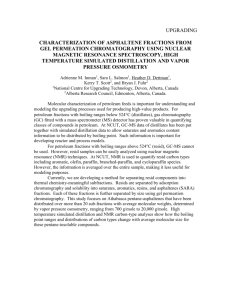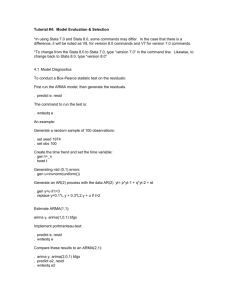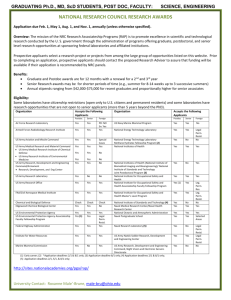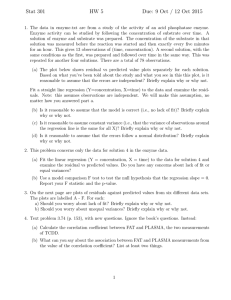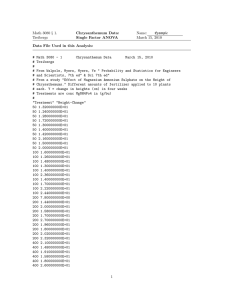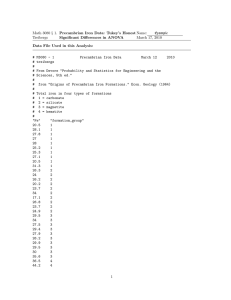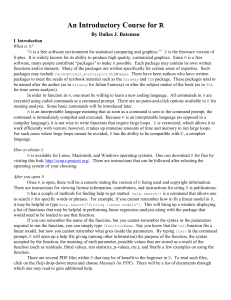Protein Structure Determination Using NMR Restraints BCMB/CHEM 8190
advertisement
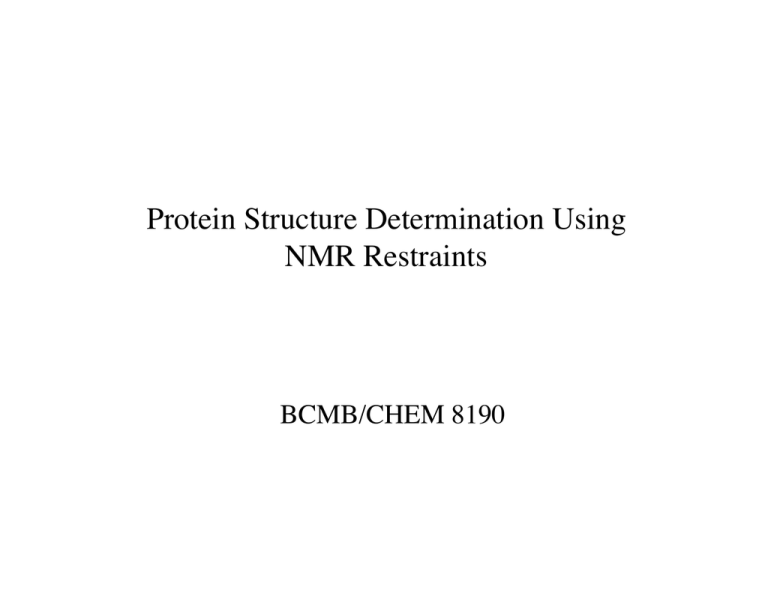
Protein Structure Determination Using
NMR Restraints
BCMB/CHEM 8190
Programs for NMR Based Structure Determination
• CNS - Brünger, A. T.; Adams, P. D.; Clore, G. M.; DeLano, W.
L.; Gros, P.; Grosse-Kunstleve, R. W.; Jiang, J. S.; Kuszewski,
J.; Nilges, M.;Pannu, N. S.; Read, R. J.; Rice, L. M.; Simonson,
T.; Warren, G. L. Acta Cryst. D 1998, 54, 905.
• X-PLOR-NIH - Schwieters, C. D.; Kuszewski, J. J.; Tjandra, N.;
Clore, G. M. J.Magn.Reson. 2003, 160, 65.
• DYANA/CYANA - Güntert, P.; Mumenthaler, C.; Wüthrich, K.
J. Mol. Biol. 1997, 273, 283.
-Güntert, P. Prog. NMR Spectrosc. 2003, 43, 105-125.
• ARIA - Linge, J. P.; Habeck, M.; Rieping, W., et al. Bioinformatics
2003, 19, 315-316.
Websites
• CNS - http://cns.csb.yale.edu/v1.1/
• X-PLOR - http://xplor.csb.yale.edu/xplor/
• X-PLOR-NIH - http://nmr.cit.nih.gov/xplor-nih/
• CYANA/DYANA - http://www.las.jp/prod/cyana/eg/index.html
• ARIA - http://www.pasteur.fr/recherche/unites/Binfs/aria/
Overview of Structure Calculations
Molecular topology
information
Experimental structural
restraints (NOE, coupling
constants, H-bond)
Template structure
Distance geometry
Simulated annealing
Regularization
Simulated annealing refinement
Structure selection
Analysis/validation (RMSD, “Procheck”, back calculation)
Adapted from Brünger, A. T., “X-PLOR Version 3.1, A
System For X-ray Crystallography and NMR”
Molecular topology
-the empirical energy function (“force field”) is defined for the
amino acids
-in CNS/X-PLOR, “parameter” files and “topology” files
• parameter files: energy constants, standard values
• topology files: atom names/types/charges
masses/connectivities for each amino acid type
residue ALA
group
atom N
type=NH1 charge=-0.36 end
atom HN type=H
charge= 0.26 end
atom CA type=CH1E charge= 0.00 end
atom HA type=HA charge= 0.10 end
atom CB type=CH3E charge=-0.30 end
atom HB1 type=HA charge= 0.10 end
…etc…
bond
bond
bond
bond
bond
N HN
N CA
CA CB
CA C
C
O
…etc…
bond CA
bond CB
HA
HB1
bond CB
-example: topology file
entry for alanine
HB2
bond CB
HB3
Experimental Restraints
- NOE data from 2D and 3D experiments are a
primary source of information
Icp = C{exp(-T) • (1 - exp(-2T)}
= 2W1 + W2 + W0, = (W2 - W0)
- crosspeak intensity proportional to 1/r6
for short mixing times
NOESY spectrum of ACP
Experimental Restraints
-Sequential NOEs (NOEs between
neighboring residues) define
secondary structure
-Short, well-defined 1H-1H distances
can be used to calibrate NOE
intensities
-In proteins, NOE intensities are
usually converted to approximate
distance ranges
NOE interactions in
an idealized -helix
• “strong”
1.8-2.7 Å
• “medium”
1.8-3.3 Å
• “weak”
1.8-5.0 Å
• “very weak”
1.8-6.0 Å
(lower bound is sum of van der Waals
radii for two protons)
Experimental Restraints
-Long range NOEs (side chain to side chain) are among
the most important in structure determination
-Provide important conformational
restraints for structural elements
in distant sections of the sequence
-Can provide proper relative orientation
of structural elements (if enough are
measured and properly assigned)
Experimental Restraints
-Example of a CNS/X-PLOR/X-PLOR-NIH input file for
NOE-based distance restraints
!V2
assign
assign
assign
assign
assign
assign
(resid
(resid
(resid
(resid
(resid
(resid
2
2
2
2
2
2
and
and
and
and
and
and
name
name
name
name
name
name
HG2#) (resid
HB) (resid 3
HA) (resid 3
HG1#) (resid
HG2#) (resid
HG1#) (resid
3 and name HN) 4.0 2.2 1.5
and name HN) 4.0 2.2 1.0
and name HN) 2.5 0.7 0.4
3 and name HN) 2.5 0.7 0.9
46 and name HN) 4.0 2.2 1.5
56 and name HN) 3.0 1.2 1.2
!#A
!#A
!#A
!#A
!#A
!#A
762 2.78e+05
760 2.82e+05
34 2.36e+06
23 1.27e+06
637 1.85e+05
348 8.33e+05
!K3
assign (resid 3 and name HB#) (resid 3 and name HN) 2.5 0.7 0.4
assign (resid 3 and name HA) (resid 3 and name HN) 3.0 1.2 0.5
assign (resid 3 and name HB#) (resid 4 and name HN) 4.0 2.2 1.0
assign (resid 3 and name HB1) (resid 4 and name HN) 4.0 2.2 1.0
assign (resid 3 and name HN) (resid 4 and name HN) 4.0 2.2 1.0
assign (resid 3 and name HN) (resid 4 and name HA) 4.0 2.2 1.0
assign (resid 3 and name HG#) (resid 4 and name HN) 4.0 2.2 1.0
!assign (resid 3 and name HG2) (resid 4 and name HN) 4.0 2.2 1.0
…..etc…..
!#A
!#A
!#A
!#A
!#A
!#A
!#A
!#A
22
21
74
37
763
32
55
54
1.45e+06
7.75e+05
3.87e+05
3.87e+05
2.01e+05
6.64e+05
2.57e+05
3.32e+05
!Q4
assign (resid 4 and name HG#) (resid 4 and name HE2#) 4.0 2.2 1.0
assign (resid 4 and name HG#) (resid 4 and name HE2#) 3.0 1.2 1.0
……etc……
!#A 694
!#A 693
4.75e+05
6.40e+05
Experimental Restraints
-Coupling constants can be used to restrain main chain an
angles (and side chain 1, 2, etc.) via Karplus relationships
-Example: HNHA
experiment for
estimating • excellent, widely
used experiment
Vuister and Bax (1993) J. Am. Chem. Soc. 115, 7772-7777.
Wang and Bax (1996) J. Am. Chem. Soc. 118, 2483-2494.
Experimental Restraints
-Chemical shift deviations from
random coil values provide
information on secondary
structure and hence and Spera and Bax (1991) J. Am. Chem. Soc. 113, 5490-5492.
-Combined with database information (, , and
corresponding chemical shifts), good quantitative predictions
for and from chemical shifts can be made, as can
uncertainties in the predictions (“Talos” program and others).
“Talos”: Cornilescu, Delaglio and Bax (1999) J. Biomol. NMR 13, 289-302.
Experimental Restraints
-As with distance restraints, dihedral angle restraints are
provided as generous ranges of values
-Example of a CNS/X-PLOR/X-PLOR-NIH input file for
and restraints
!remark phi angle constraints
!!
v2
assign (resid
(resid
!!
k3
assign (resid
(resid
!!
q4
assign (resid
(resid
1
2
and name c ) (resid
and name ca) (resid
2
2
and name n )
and name c )
1.0
-125.0 25.0 2
2
3
and name c ) (resid
and name ca) (resid
3
3
and name n )
and name c )
1.0
-152.0 20.0 2
and name c ) (resid
and name ca) (resid
…etc…
!remark psi angles constraints
4
4
and name n )
and name c )
1.0
-95.0 20.0 2
!!
m1
assign (resid
(resid
!!
2
assign (resid
(resid
!!
k3
assign (resid
(resid
3
4
1 and name n ) (resid 1 and name ca)
1 and name c ) (resid 2 and name n )
1.0
180.0 50.0 2
2 and name n ) (resid 2 and name ca)
2 and name c ) (resid 3 and name n )
1.0
180.0 50.0 2
1.0
120.0 50.0 2
3 and name n ) (resid 3 and name ca)
3 and name c ) (resid 4 and name n )
…etc…
Experimental Restraints
-Hydrogen bond restraints can be determined from direct
NMR observation or from other physical data (hydrogen/
deuterium exchange)
-Example of a CNS/X-PLOR/X-PLOR-NIH input file for
hydrogen bond restraints for a well-defined -helical region
! hydrogen bond
!
assign (segid AS1 and resid
assign (segid AS1 and resid
assign (segid AS1 and resid
assign (segid AS1 and resid
assign (segid AS1 and resid
assign (segid AS1 and resid
assign (segid AS1 and resid
assign (segid AS1 and resid
assign (segid AS1 and resid
assign (segid AS1 and resid
assign (segid AS1 and resid
assign (segid AS1 and resid
assign (segid AS1 and resid
assign (segid AS1 and resid
assign (segid AS1 and resid
assign (segid AS1 and resid
10
10
11
11
12
12
13
13
14
14
15
15
16
16
17
17
and name O
and name O
and name O
and name O
and name O
and name O
and name O
and name O
and name O
and name O
and name O
and name O
and name O
and name O
and name O
and name O
)
)
)
)
)
)
)
)
)
)
)
)
)
)
)
)
(segid AS1 and resid
(segid AS1 and resid
(segid AS1 and resid
(segid AS1 and resid
(segid AS1 and resid
(segid AS1 and resid
(segid AS1 and resid
(segid AS1 and resid
(segid AS1 and resid
(segid AS1 and resid
(segid AS1 and resid
(segid AS1 and resid
(segid AS1 and resid
(segid AS1 and resid
(segid AS1 and resid
(segid AS1 and resid
14
14
15
15
16
16
17
17
18
18
19
19
20
20
21
21
and name HN
and name N
and name HN
and name N
and name HN
and name N
and name HN
and name N
and name HN
and name N
and name HN
and name N
and name HN
and name N
and name HN
and name N
) 1.9 0.1 0.1
) 2.85 0.15 0.15
) 1.9 0.1 0.1
) 2.85 0.15 0.15
) 1.9 0.1 0.1
) 2.85 0.15 0.15
) 1.9 0.1 0.1
) 2.85 0.15 0.15
) 1.9 0.1 0.1
) 2.85 0.15 0.15
) 1.9 0.1 0.1
) 2.85 0.15 0.15
) 1.9 0.1 0.1
) 2.85 0.15 0.15
) 1.9 0.1 0.1
) 2.85 0.15 0.15
Generating Initial Structures: Distance Geometry
Braun, W. (1987) Quart. Rev. Biophys. 19, 115-157
Crippen and Havel (1988) Distance Geometry and Molecular Conformation
- Calculate Cartesian coordinates directly from known
(covalent structure) and experimental distances
-First generate the “metric matrix”
• write n n matrix of distances
• calculate n n metric matrix of vector products
Generating Initial Structures: Distance Geometry
-Then solve for positions in Cartesian space:
• diagonalize M; || = |A| |M| |A-1|; |M| = |A-1| || |A|
-the diagonal matrix corresponds to vectors in real space
• only 3 eigenvalues should be finite (ri•ri finite only for x•x, etc)
-corresponding eigenvectors contain Cartesian coordinates
ri•ri = k kAik-1Ajk = Aj1-1Ai1+Aj2-1Ai2+Aj3-1Ai3 = xixi + yiyi + zizi
• hence, elements of A are x,y,z coordinates of atoms
-Problems
• incomplete distance matrix
• experimental distances are not exact
-in practice, use upper and lower bounds and fill in matrix
by random number selection within bounds
• solution is approximate
-experimental distances are often significantly different
than calculated distances and must be “regularized”
Detailed tutorial: http://www.colby.edu/chemistry/CompChem/MOEtutor03.pdf
Generating Initial Structures: Simulated
annealing and error functions
E = Ebond + Evdw + Eangle + ….. + ENMR
ENMR = I (robs - rtrial)I2 …(or use rmin,max for robs)
xnew = xold + t • vx = xold + t • axdt,
ax = Fx/m = -(1/m) • dE/dx + arand(T),
ynew = …
ay = …
Simulated Annealing
Initial Structure
Energy Minimization
-local energy minimum reached
Heat System (~1000 K)
Restrained Evolution
Simulation
Steps (~5000)
Cooling (by 50 K)
Repeat With
New Initial
Structure
(~20 x)
Increase Force Constants
Restrained Evolution
20 x
Simulation
Steps (~5000)
-heat system to cross local
energy barriers
-atomic positions determined
from velocities/accelerations
-slow reduction of atomic
velocities (many steps)
-increase weights of
experimental restraints
Final Energy Minimization
Energy Minimized Structure
Family of Structures
Based on figure from Horst Joachim Schirra Max-Planck Institute for Biochemistry
http://www.cryst.bbk.ac.uk/pps2/projects/schirra/html/home.htm
-global energy minimum?
Structure Refinement
-Simulated annealing methods can be used to refine structures
-Refinement can include additional restraints, changing weights
or force constants for restraints, using NOE intensities
directly, etc.
-Ultimately, ensembles of structures are calculated and compared
20 NMR structures
for DNA J
25 NMR structures
for AsiA
Validation of Structures
• R factor for NOEs: n ~ 1/6
• R = NOEs[(Iobs)n - (Icalc)n] / NOEs[(Iobs)n
• Other statistics: RMSD of backbone
and all atoms
• NOE violations
• Molecular energy
• “Procheck” output
Validation of Structures
-Example: RMSD improves with number of (NOE) restraints
• IgG binding domain of streptococcal protein G (56 residues)
Clore, G. M. et al. (1993) J. Mol. Biol. 231, 82-102.
• interleukin 1 (153 residues)
Clore et al.
Left
Right
# distance
restraints
536
2780
RMSD
(backbone)
2.0
0.4
Validation of Structures
- “Procheck”: performs a number of checks of
structural quality
• covalent geometry
• planarity
• dihedral angles
• chirality
• non-bonded interactions • disulfide bonds
• main chain hydrogen bonds
• stereochemical parameters
• residue-by residue analyses
• other parameter comparisons
-Laskowski R A, MacArthur M W, Moss D S & Thornton J M (1993) J. Appl. Cryst., 26, 283-291
-Morris A L, MacArthur M W, Hutchinson E G & Thornton J M (1992) Proteins, 12, 345-364
-http://www.biochem.ucl.ac.uk/~roman/procheck/procheck.html
Procheck Example
-Distribution of phi-psi angles (Ramachandran plot)
• Most , pairs should
fall in favoured or
allowed regions
Procheck Example
-Bond length and bond angle distortions
-Bond length and bond
angle variations from
normal values can
signify potential
structural distortions
Bond lengths (red) differing (differences in green) by > 0.05 Å
from small-molecule values (blue)
Ambiguous Distance Restraints (ADRs)
-Ambiguous NOEs are those for which more than one assignment
is possible
N
• The volumes (intensities) of these
Vtotal =
Va
can be treated as sums of possible
contributions…..
a=1
N
Vcalc d a6
• ….. and can be approximated with
a 6th power law
a=1
N
1/ 6
6 D da a=1
• Ambiguous distance restraint: an
effective or summed “distance”
between more than two points
-Ambiguous NOEs can be used in iterative procedures for
simultaneous structure calculation and NOE assignment
Ambiguous Distance Restraints (ADRs)
-ARIA: Ambiguous Restraints
for Iterative Assignment.
• ambiguous restraints are
assigned as structure
calculations proceed.
• number of NOEs assigned
uniquely increases in
subsequent iterations
coupled with improved
RMSD
-Are routines in X-PLOR-NIH
and CYANA that perform
similarly
Nilges et al., (1997) J. Mol. Biol. 269, 408-422
Structure Refinement Using RDCs
Write RDCs in principal alignment frame:
D = (Da/r3){(3cos2-1)/r3 + (3/2)Rsin2cos(2)}
Write error function in terms of Dmeas and Dcalc
ERDC = (Dmeas - Dcalc)2
Seek minimum in ERDC to refine structure Need to float alignment axes during search
REsidual Dipolar Coupling Analysis Tool
(REDCAT)
Valafar, H., & Prestegard, J. H. (2004) J. Magn. Reson. 167, 228-241
Dosset, Hus, Marion & Blackledge (2001) J. Biomol. NMR 20, 223-231
• Given a proposed structure and RDCs,
calculates order tensor solutions.
• Finds best order tensor solution.
• Gives principal elements and Euler angles.
• Back-calculates RDCs.
• Estimates errors and helps identify
problematic data
